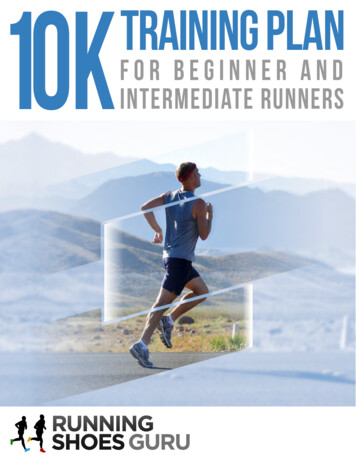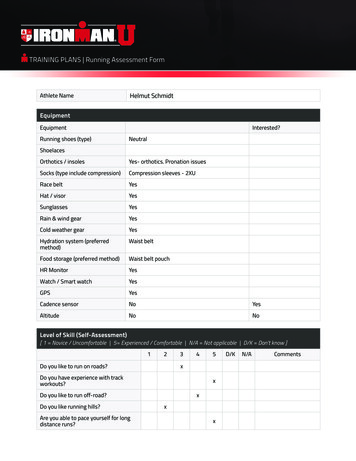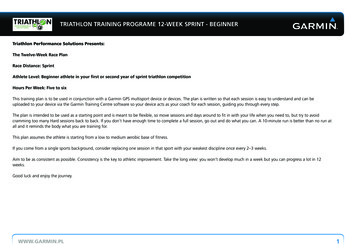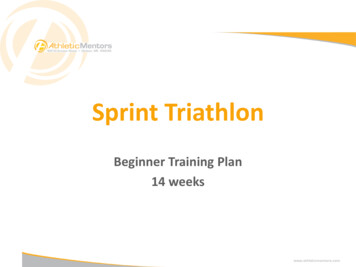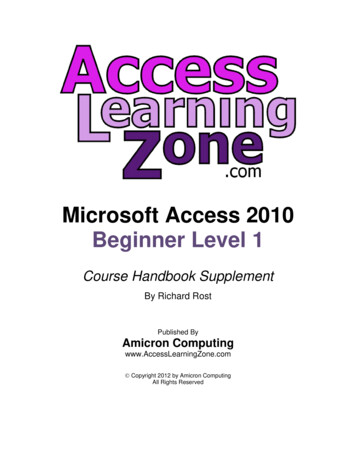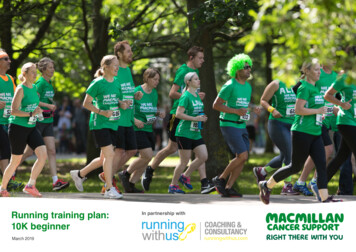
Transcription
Running training plan:10K beginnerMarch 2019In partnership with
Macmillan Cancer SupportRunning training plan: 10k beginnerIntroduction2IntroductionThis training plan, put together by our coaching partners Running With Us, is designed to getyou to the start line of the 10k feeling prepared and confident that you can achieve your goal.1234Is this the right plan for me?This 10 week beginners runner’s plan is designed for those who are eithernew to regular running or those stepping up to longer distances for thefirst time. This plan will see you training 3-4 times a week and we wouldencourage you to complement the running outline with core conditioningand XT as outlined in our Running Guide.What if I’m not there yetThis training plan is suitable for beginners mixing running with walking.Really focus on holding back your effort on your easy runs – many beginnerrunners try to run them a little too hard. You can always mix the sessions inthe plan with XT.Why train in this way?If you keep doing the same things over and over again you can’t expectdifferent results. This plan is designed to add variety, structure andprogression to your training. It will challenge you across a range ofdifferent heart rate zones and gradually build up your ability to run at yourdesired 10k pace.Is this everything I need to know?No – this plan is supported by our Running Guide, which gives moredetail on the structure of the running sessions and top tips on nutritionand recovery to leave you fitter, stronger and more energised as youprogress through your training journey.56What do all the terms mean?All the training schedules involve a broad variety of training sessions andintensities. We have a full glossary of different terms you will see in thisguide, such as ‘threshold running’ and ‘progression runs’.What if I miss a session, pick up a niggleor get sick?No training plan is designed to be a tablet of stone; it’s a guide and onlyone approach to get you in great shape. Training for a 10k is a journey,though, and doesn’t always go smoothly. Feel free to chop and change theplan and shift runs to different days that may work better for you. Take carenot to run back-to-back ‘hard’ days – so try to avoid running a thresholdsession followed the next day by a hill session, for example.If you miss days through work, holiday, sickness or injury, don’t try to playcatch-up. Step back into the plan where you left off, and be patient. If youfeel you need to catch up, check out our cross-training tips in the RunningGuide . don’t just add more running unless you are ready.NotesAlways include a 10 minute easy warm up and cool down either sideof ‘threshold’, ‘hill’ or ‘interval’ efforts. Check out our Running Guide for ourtop core exercises and stretches. Remember to stretch well after every run.
Macmillan Cancer SupportRunning training plan: 10k beginner‘Feeling’ your sessions3‘fe INg’y Ur eSs O SThe feeling of not being sure how fast you should be running for any particularsession is common, from beginners to elite athletes. For beginners it neverfeels as though running is easy but we can assure you that running doesn’tneed to be hard all the time. There are a number of different paces that youshould aim to master which will make up your training:Easy runsSteady runsThreshold runsInterval runsFully conversational at the speedof chat and about 6/10 effort.Conversational, controlled butworking at about 7/10 effort.Controlled discomfort and 3-4word answer pace 8/10 effort.3k-5k-10k effort or 9/10 effort.At the beginning all you are trying todo is get out and run. That should beat easy pace or ‘the speed of chat’ – ifyou can’t talk as you are running, you’regoing too fast. For the more experiencedrunner, ‘the speed of chat’ is how youreasy and recovery runs should feel –totally in control and relaxed. If you arecombining walking and running, the effortlevel remains the same – you should beable to hold a conversation on both thewalking and running segmentsFaster than easy, conversational runningis ‘steady running’. This is the backboneof training for more experienced runners.This is where you must be honest and notpush too hard or you might ruin your fastersessions, so conversation should still bepossible, but a little strained.Incorporating threshold running is howthe elites train. This is where you arerunning at a controlled discomfort level.You can still talk between breaths, butonly 3 or 4 word phrases. This is notrunning to exhaustion or sprinting. Youmay already feel able to include some3-5 minute blocks into a run each weekwhich will grow in volume throughoutyour training as per your training plan.Interval training and 5k/10k pace is topend training. This is often called the ‘hurtlocker’ and is used in training to replicatethe feeling at the end of a hard race. Theeffort levels here should be almost atmaximum.
Macmillan Cancer SupportRunning training plan: 10k beginnerGlossaryg oSs YHere you will find a glossary of the terms used in our training plans.Continuous Hills (CH)Hill running develops strength in your muscles and tendons withoutputting them under the type of stress they are exposed to during fasterrunning. Run up a 5-10% gradient for 45-90 seconds at a ‘thresholdeffort’. Turn immediately at the top and run down the hill at the sameeffort, then turn at the bottom and repeat without any recovery untilthe rep time ends. Like a tempo/threshold run, a hill session is time toconcentrate, as you should be working at about 80–85% of MHR and beable to utter just a few words.Cross-Training & Core Conditioning (XT)It is important that your training is balanced with some non-impactactivities such a swimming, cycle and rowing. Without this you are morelikely to pick up an injury that will set your training back. Endurancerunning, especially the marathon, requires whole body conditioning. Theachieve this you should aim to work a variety of muscle groups and notjust you legs.Fartlek (F)This is a Swedish term that literally means “speed play”. It involves anumber of bursts of effort over a variety of distances with a variablerecovery. Originally the length of effort was based on the terrain, forexample, pushing harder every time you came to a climb, no matter howlong it was. You can adapt it for your needs.Interval Training (IT)Intervals help to boost specific race pace speed and involve running timedefforts with a controlled recovery. The effort level is around 85–100% ofMHR, depending on the duration of the event you are training for and thelength and volume of intervals used. A typical example might be 6 x 3minutes @ 5km race pace with a 90 second jog recovery.Maximum Heart Rate (MHR)To make sure you increase your fitness and strength safely, it is importantthat you increase your heart rate to the right level while you are exercising.This means working out a safe range for your heart rate when you aretaking exercise. To do this, you first need to work out your maximum heartrate. The maximum heart rate depends on your age. One way to work outyour maximum heart rate is to take your age away from 220.4
Macmillan Cancer SupportRunning training plan: 10k beginnerGlossary5Long Runs (LR)Long runs are vital in your plan and key to racing well in long distanceraces from 5km – marathon. At first, concentrate on increasing the timeon your feet rather than worrying about distance. Start off by headingout for at least an hour and run at a conversational pace or 6/10 effort.Gradually this will build to 75% of WHR as you start to practice periodsof marathon or race pace running. These runs improve your muscularendurance and condition your body to burn fat as its primary fuel source.Rest (R)To help your body cope with the workload, rest is going to be asimportant a part of your training schedule as the running itself. Listen toyour body and take heed of any warning signs. If you feel fatigued evenbefore you’ve run a step, find yourself thinking up excuses not to run orstart suffering a series of minor injuries; you probably need more timeoff. Taking enough rest allows physical and mental recovery and givesyour body the time to adapt to your workload.Marathon Pace (MP)Understanding the pace and effort you intend on running your marathonat is very important. Pace judgment and patience on the big day will becrucial to running your best marathon. Marathon pace practice allows yourbody and mind to get used to what will be required on race day, and itbuilds endurance quickly.Threshold Runs (THR)After the long run threshold runs are probably your most valuableworkouts. They are run at a controlled brisk pace, about 80–85% ofyour MHR, you’ll only be capable of uttering a couple of words to yourtraining partners. Tempo/threshold runs improve your lactate threshold(the speed above which your body struggles to cope with the lactic acidcreated by burning energy without oxygen), your running economy andaerobic capacity.Recovery Run (RR)Training for endurance requires your body to work harder than it hasever done. To see improvement without breaking down, you’ll needsome recovery runs. These should be nice and easy and you shouldfeel relaxed. Enjoy the scenery. You should be breathing easily and becapable of holding a conversation throughout the run. This will mean thatyou are running in the 60–65% range of your MHR and it should be nomore than 45 minutes in duration. It also helps with the removal of thewaste products which accumulate in your muscles after harder efforts.Warming Up/Warm Down (WU/WD)When you are going to do any faster training such as hills or thresholdruns, it is important to warm up gradually. A 10-15 minute jog gets yourmuscles warm and improves your range of movement.
Macmillan Cancer SupportRunning training plan: 10k beginner10K beginner training plan / 1310k beginner training plan / 1WeekMondayTuesdayWednesdayThursday12RestEasy run:2 x 10 mins easy runwith a 5 mins brisk walkrecovery.RestEasy run:20 mins run.RestIntervals run:10 mins easy run,then 3 x (3 mins atthreshold with 2 minswalk/jog recoveries).4536FridaySaturdaySundayRestEasy run:2 x 12 mins easy runwith a 3 mins brisk walkrecovery.RestRestor 20-30 mins aerobicXT easy.Easy run:2 x 15 mins easy runwith a 5 mins brisk walkrecovery.RestEasy run:20 mins run.RestRestor 20-30 mins aerobicXT easy.Easy run:30 mins run.Easy run:40 mins run(if needed do as2 x 20 mins with a5 mins brisk walk).RestEasy run:30 mins run.RestRestor 30 mins aerobicXT easy.RestIntervals run:10 mins easy run then3 x (4 mins at thresholdwith 2 mins walk/jogrecoveries) then 10 minseasy run.RestIntervals run:30 mins run as:10 mins easy,10 mins steady(very slightly faster),10 mins easy.RestRestor 30 mins aerobicXT easy.Easy run:40 mins run.RestEasy run:30 mins run.RestEasy run:40 mins run.RestTime trial:Parkrun or self timed5km time trial.Easy run:30 mins run.RestIntervals run:3 x 5mins at threshold, /2 mins jog recoverieswithin 30 mins run.RestRestor 30 mins aerobic XT,middle 20 is 2 minsharder / 3 mins easyx 4.Long run:50 mins run.RestEasy run:35 mins run.
Macmillan Cancer SupportRunning training plan: 10k beginner10K beginner training plan / 2710k beginner training plan / 2Week78910MondayTuesdayRestIntervals run:4 x 5 mins at threshold,90 secs jog recoverieswithin a 40 mins run.RestIntervals run:4 x 6 mins atthreshold / 2 mins jogrecovery within a30-40 mins run.RestIntervals run:Fartlek session of6 mins, 5 mins, 4 mins,3 mins, 2 mins, 1 min(90 secs jog recoveries).RestIntervals run:5 x 3 mins at threshold /2 mins recovery within a30 mins ession run:10 mins easy pace10 mins steady pace10 mins nearingthreshold.RestRestor 30 mins aerobic XTwith the last 15 minsharder than the first core.Long run:50-60 mins run.RestProgression run:20 mins easy 20 mins steady(no recovery).RestRestor 40 mins XT middle20 is 2 mins harder / 3mins easy x 4.Long run:60-70 mins run.RestProgression run:15 mins easy pace15 mins steady pace15 mins nearingthreshold.RestRestor 30 minsaerobic XT.Easy run:40 mins run.RestEasy run:20 mins easy.XT:20 minsaerobiceasy.Rest10k race:Good luck!
Macmillan Cancer SupportRunning training plan: 10k beginnerImportant notes8Important noteswu tWarm ups and cool downsStretchMorning recoveryEatIf you’re feeling OK, you may wish to consider a 20–30minute recovery run in the morning before any of the qualitysessions above.Always eat within 20–30 minutes of finishing a run.Cross TrainingPacingAlways substitute running for cross training if you areinjured, very sore or it’s not safe to run.Always train at the specified paces; don’t compromise orrun too hard. Tiredness always catches up, so take extrarest if required.It is important to do a 15 minute warm-up and cool-downbefore threshold, continuous hills or interval sessions.Core conditioningPlease add core conditioning, pilates or yoga classes onceor twice a week if you have time.Try to stretch every day for at least 10 minutes.
Macmillan Cancer SupportRunning training plan: 10k beginnerContact9ContactWe’re here for youFor support, information or if you just want to chat,call us free on 0300 100 0200 (Monday to Friday, 9am–5pm)or visit macmillan.org.ukfa Cc aT? AMacmillan.org.ukMacmillan Cancer Support, registered charity in England and Wales (261017),Scotland (SC039907) and the Isle of Man (604). Also operating in Northern Ireland.
#te MAc iLl
Macmillan Cancer Support 10K beginner training plan / 1 3 10k beginner training plan / 1 Week Monday Tuesday Wednesday Thursday Friday Saturday Sunday 1 Rest Easy run: 2 x 10 mins easy run with a 5 mins brisk walk recovery. Rest Easy run: 2 x 12 mins easy run with a 3 mins brisk walk recovery. Rest Rest or 20-30 mins aerobic XT easy. Easy run:
